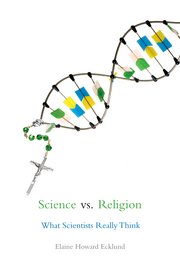Book Review: Science vs. Religion
Science vs. Religion:
What Scientists Really Think
by Elaine Howard Ecklund
Review by Brian Polk
I recently heard the word stereotype defined as an exaggeration of the truth. Is the stereotypical narrative of the innocent Christian student being thrown to the wolves of liberal higher education true? Rice University sociologist Elaine Ecklund sets out to answer that question in her book Science vs. Religion: What Scientists Really Think by surveying close to 1,700 scientists in twenty-one elite academic institutions. She sent them a thirty-four question survey and followed up with 275 personal interviews to ascertain her data.
The war between science and faith dates back at least to Galileo’s visit to the Vatican 370 years ago when he agreed with Copernicus’s model of heliocentrism. But more recently, and largely due to popularizers of secular thought like Richard Dawkins—and even Bill Nye, “The Science Guy”—the debate has escalated and seems to require us to choose sides. Each year Christian families send children off to secular universities hoping for intellectual growth and development, yet fearing their child may have a crisis of faith if they are forced to stand up to an atheist professor or accept a secular humanist worldview. Yet Ecklund found that close to 50 percent of the scientists interviewed—both natural and social science professors from top secular research universities—identify themselves as religious, and some of them teach Sunday School. Nearly 25 percent of the atheists and agnostics considered themselves to be spiritual. With the exception of a vocal minority, most academic scientists are supportive of their students’ faiths and encourage their desires to pursue religious practices. To quote the author, “After four years of research, at least one thing became clear: Much of what we believe about the faith lives of elite scientists is wrong.”
The book is organized into two parts. The first sets the context for the sociological research by describing the personal religious life of many of the respondents. The second part expounds upon the research and details specifically how the findings intersect with segments of the population, portraying a more societal rather than personal context of the research. In the chapter entitled, “God on the Quad: Making Room for Faith on Campus,” Ecklund writes, “A particular calling for religious scientists might be to foster dialogue about religion and science more broadly on their campuses, encouraging students to think through and reevaluate the frameworks with which they were raised, equipping them as ambassadors of scientific knowledge within their own faith communities.”
While history and philosophy are integral to the conversation about science and religion, trustworthy research is important as well. Ecklund provides data from individual voices that represent a broad spectrum of convictions drawn from her sampling of actual academic environments. Her “moderately optimistic” conclusions about the actual “state of the union” are based on deep and broad data rather than on sweeping generalizations.
The book addresses both the myths that scientists have about religious people, as well as the misconceptions the religious hold about scientists, concluding that much of the tension between science and faith seems to come from exaggeration, not fact. This important study seeks to foster understanding and respect, recognizing that both science and religion are fundamental sectors of a pluralistic society.

